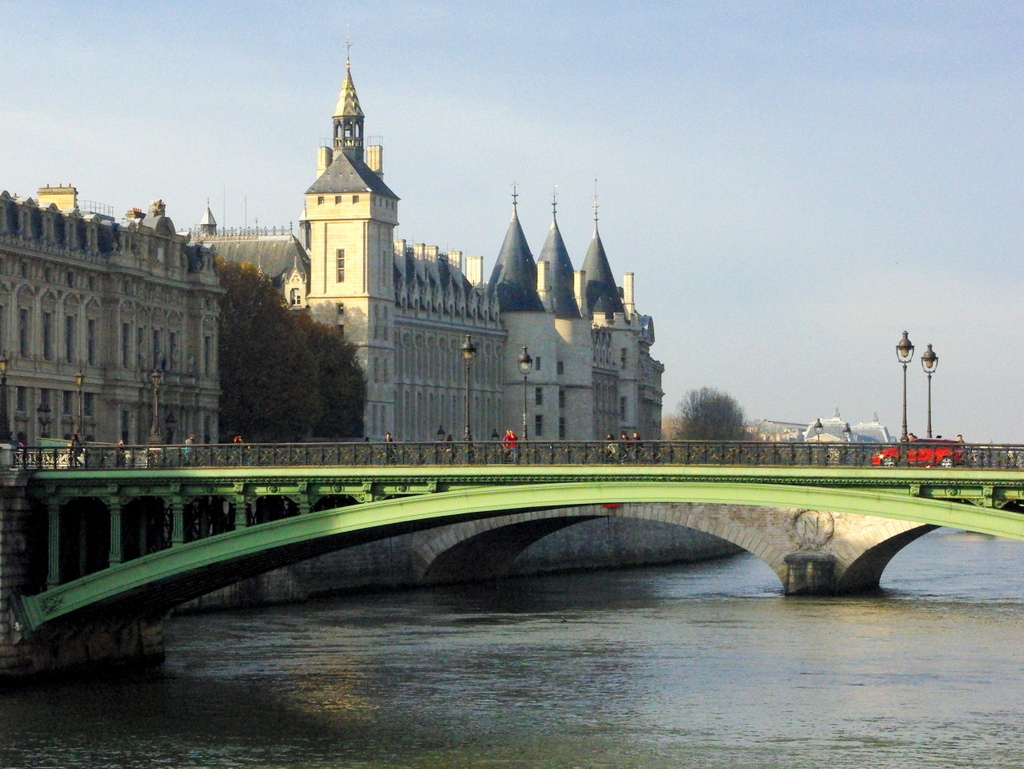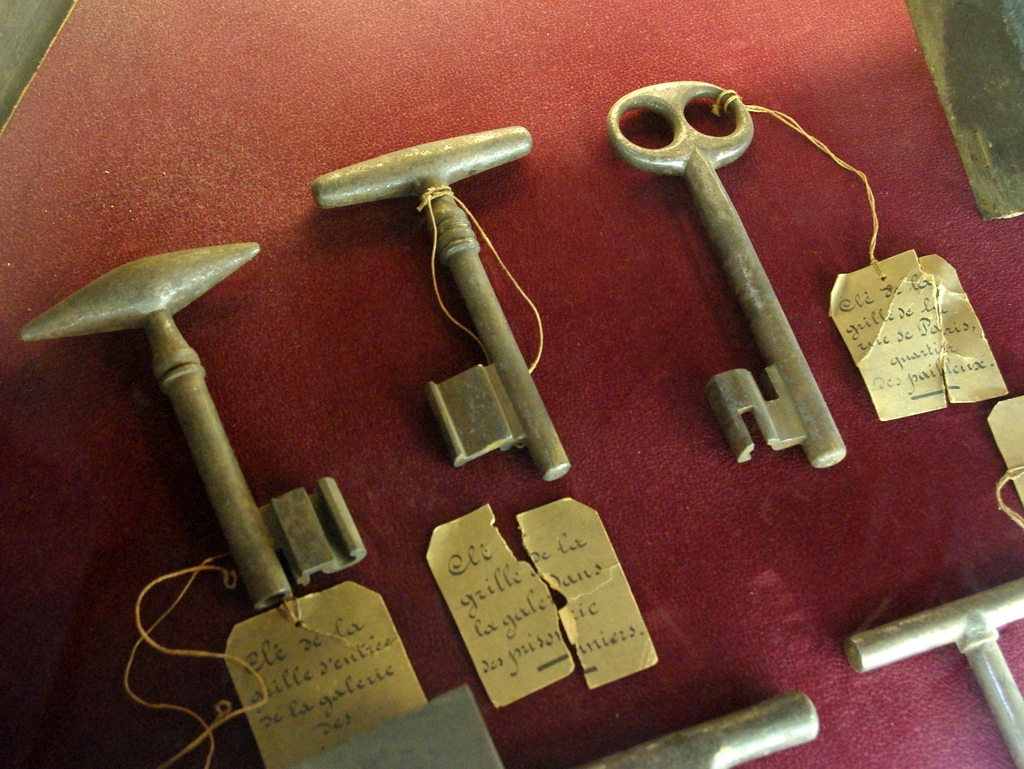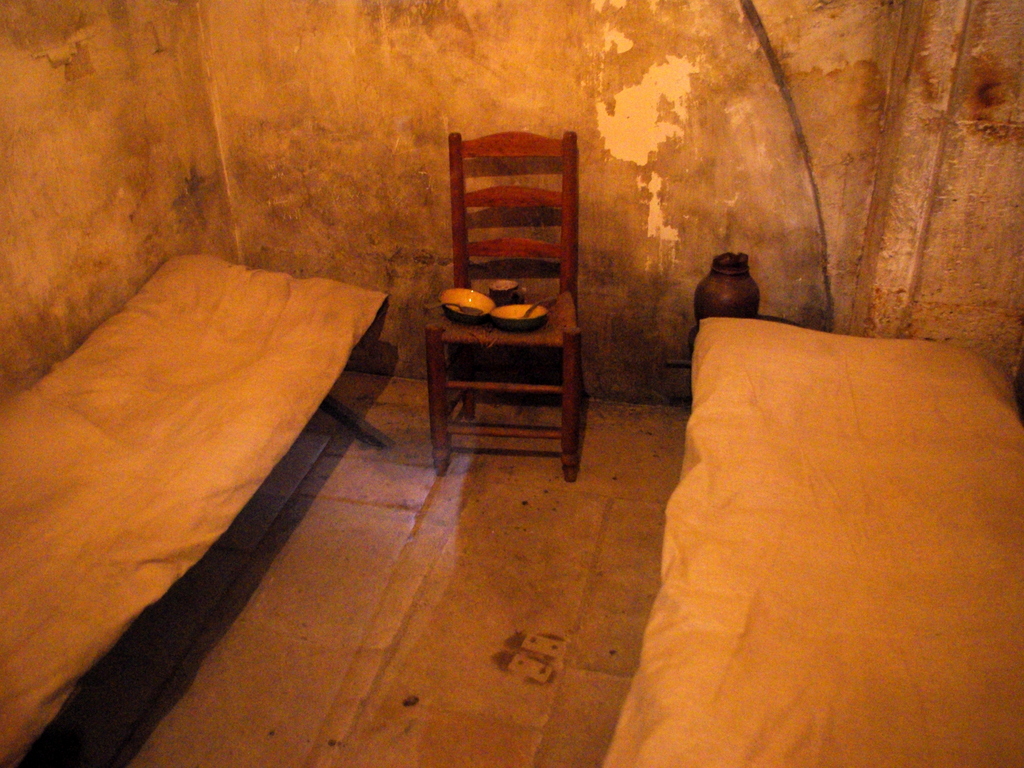With its distinctive towers, the Conciergerie on the Île de la Cité used to belong to the Kings of France.
In fact, it even preceded the Louvre as their royal residence. During the French Revolution, it became notorious for being a prison.
And even more, a dreadful antechamber to the guillotine. However, once inside the monument, visitors will discover one of the finest examples of Gothic secular architecture in Europe.
The Conciergerie: a bit of history

The Conciergerie is situated on the Île de la Cité, an island on the Seine that is closely linked to the history of Paris.
Today, the Conciergerie occupies the north part of the old royal residence of Palais de la Cité, which is believed to have been founded in the 6th century by Clovis, the first French king.

During the Middle Ages
In the 10th century, Hugh Capet, the first Capetian king, established his council and government in the Palais de la Cité, which became the seat of royal power.
In the King’s absence, le Concierge was appointed a keeper to hold command of the royal residence, hence the term “Conciergerie.”
This title was regarded as a very high-ranking one, as the Concierge was considered the King’s housekeeper.

The Conciergerie remained the seat of the kings of France from Hugh Capet to the 14th century.
The palace was extended and fortified under Louis IX (Saint-Louis) and Philip IV (Philip the Fair).
The latter added the façade towers and a large Gothic hall.
Following the incursions of the bourgeois led by Etienne Marcel in 1358, King Charles V left the Conciergerie to the Hôtel Saint-Pol in the Marais (which no longer exists today).
Later, the Kings of France would establish their royal residence in the Louvre while enjoying residing in the chateaux of the Loire.
As for the Conciergerie continued to be used as the seat of the Parliament of Paris (the highest judicial court in the kingdom).
In addition, part of the building was converted as a prison in 1391, housing a mixture of common outlaws and political detainees, such as Ravaillac (King Henry IV’s assassin).

During the French Revolution
During the French Revolution, the people of Paris nicknamed the Conciergerie ‘the antechamber to the guillotine‘.
It became the central penitentiary of a network of prisons throughout Paris. In March 1793, the Revolutionary Tribunal sat in the Grand Chamber.
In July 1793, Robespierre inaugurated the ‘Reign of Terror’, which ordered the arrest of anyone presumed to be an enemy of the Revolution or who confessed to being so.
The Conciergerie housed as many as 1,200 prisoners at once.
Between September 1793 and July 1794, the tribunal’s public prosecutor, Quentin Fouquier-Tinville, judged more than 2,700 people.
For most of them, it was the final stop before being picked up by cart to one of the guillotines set throughout Paris.
Famous prisoners included Queen Marie-Antoinette, Charlotte Corday, Madame Elisabeth, Madame du Barry, Georges Danton and Robespierre.

From the 19th century up to today
In the 19th century, the Conciergerie and the whole Palace of Justice underwent a major restoration.
The Conciergerie was listed as a historic monument by the French State in 1914.

=> Click here to get your entrance ticket to the Conciergerie and Sainte-Chapelle! <=
The Façade of the Conciergerie by the Seine

The medieval façade of the Conciergerie is best seen from the Mégisserie Quay on the Right Bank.
The building includes four towers that originally had their feet in the River Seine when the banks had not yet been built.
The Bonbec Tower (Tour Bonbec)

Bonbec Tower is the oldest tower of the Conciergerie. Its foundation dates back to the 11th century.
The crenellated Bonbec Tower means ‘good beak’, for it housed the torture chamber where the prisoners were encouraged ‘to sing’ (to confess).
The Bonbec Tower was restored in 1935 after a devastating fire.
The Silver Tower (Tour d’Argent) and Caesar Tower (Tour de César)

The Silver Tower was believed to be used as a storeroom where the royal treasure was kept.
Its twin round tower, the Caesar Tower, was named in honour of the Roman Emperors.

The Clock Tower (Tour de l’Horloge)

Built between 1350 and 1353, the tower is the tallest (47m tall).
Since 1371, it has housed the remarkable clock, which helped Parisians regulate their activities during the day and night.



Inside the Conciergerie
The lower parts of the Conciergerie are the only ones still standing today from the Middle Ages.
They were used by the Royal Guard and the staff members (clerks, officers, and servants) who worked for the king and his family (about 2,000 people in all).
Interestingly, the floor level of the medieval halls is still the same as it was in the 14th century, despite the construction of embankments in the 19th century.
Hall of the Men-at-Arms (Salle des Gens d’Armes)

In the Middle Ages, the Great Hall (Grande Salle) was one of the largest in Europe.
It was destroyed by fire on the night of 5 March 1618.
Although the room is no longer standing, its lower floor remains.
This is the stunning Hall of the Men-at-Arms.
Built between 1302 and 1313 by Enguerrand de Marigny, the four-aisled Gothic hall is 64m long, 27.5 wide and 8.5m high, a similar size to those of the Mont-Saint-Michel and the Popes’ Palace in Avignon.

The room was used as a dining room for the 2,000 staff members, for royal banquets and judicial proceedings.
Four large fireplaces once heated the dark hall, which was lit by many windows, which have since been blocked.
Guard Room (Salle des Gardes)

The Gothic vaulted room was built around the same time as the Hall of Men-at-Arms.
The hall is supported by stout pillars with interesting capitals, such as the central pillar which is thought to portray Heloise and Abelard.
The Guard Room was the antechamber to the Great Hall on the upper floor (which has disappeared since), where the King held meetings with his council and dispensed justice.
From 1793 to 1794, public prosecutor Quentin Fouquier-Tinville presided over the Revolutionary Tribunal.
The Kitchen
The kitchen was built during the reign of John II the Good (1319-1364).
Only the lower level of the original outbuilding remains today.
Provisions were delivered there directly by the Seine.
Four big fireplaces were built in each kitchen corner to cook enough food to feed between 2,000 and 3,000 people.
The passageway of Rue de Paris

Once part of the Hall of the Men-at-Arms, the small hall was later separated from it and raised in the 15th century.
Serving as a corridor between the Guard Room and the Revolutionary Halls, it owes its name to the executioner during the French Revolution, “Monsieur de Paris“.
There were imprisoned the poorest prisoners who could not afford to pay for better accommodation in a cell.
As they were sleeping on straw (la paille), they were named ‘Pailleux’ or ‘Payeux’. It now houses a small gift shop.

The Revolutionary Halls
Once passed through the Rue de Paris to the left, the visitor discovers another part of the Conciergerie: the Revolutionary Halls.
The premises were used during the Revolution, but they were modernised following the 1776 fire that occurred under the reign of Louis XVI.



The Prisoner’s Gallery

This is the main axis of the prison where prisoners could wander freely.
The Girondins’ Chapel

Where stands the Girondin’s Chapel already existed a little royal chapel remodelled in 1776.
Marie-Antoinette’s Chapel

Next to the Girondins’ Chapel stands the chapel dedicated to Marie-Antoinette.
This 1815 expiatory chapel occupies the cell where Marie-Antoinette spent the final two months of her life, from 2 August to 16 October 1793.
On that date, 37-year-old Marie-Antoinette was taken from the Conciergerie to the execution site.
She was driven in an open cart through Rue Saint-Honoré to Place de la Révolution (today Place de la Concorde).
She was guillotined at 12:15 pm, nine months after her husband, King Louis XVI.
To pay your respects to Marie-Antoinette, reach her final resting place: the Basilica of St-Denis (North of Paris).
Marie-Antoinette’s Cell (removed from the monument)

Until recently, visitors would discover a reconstitution of the cell where Marie-Antoinette was imprisoned.
There was a cot, a chair, a table, and a screen that separated the queen from watchmen day and night.
The reconstituted cell dating from 1989 is no longer today due to the disarray of many visitors who were familiar with it.

The Women’s Courtyard

In the courtyard, women prisoners were allowed out of their cells during the day to wash their clothes and eat at stone tables.
Corner of the Twelve

Next to the women’s courtyard is a corridor known as “Côté des Douzes“, where prisoners of both sexes could talk through the bars.
From there, inmates in groups of twelve waited for the cart that would lead them to the guillotine.
=> Click here to get your entrance ticket to the Conciergerie and Sainte-Chapelle! <=




